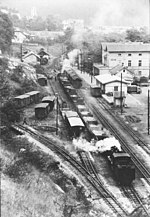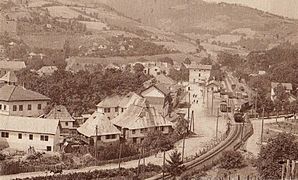Lašva – Donji Vakuf – Jajce / Bugojno railway line
| Lašva – Donji Vakuf – Jajce / Gornji Vakuf | |||||||||||||||||||||||||||||||||||||||||||||||||||||||||||||||||||||||||||||||||||||||||||||||||||||||||||||||||||||||||||||||||||||||||||||||||||||||||||||||||||||||||||||||||||||||||||||||||||||||||||||||||||||||||
|---|---|---|---|---|---|---|---|---|---|---|---|---|---|---|---|---|---|---|---|---|---|---|---|---|---|---|---|---|---|---|---|---|---|---|---|---|---|---|---|---|---|---|---|---|---|---|---|---|---|---|---|---|---|---|---|---|---|---|---|---|---|---|---|---|---|---|---|---|---|---|---|---|---|---|---|---|---|---|---|---|---|---|---|---|---|---|---|---|---|---|---|---|---|---|---|---|---|---|---|---|---|---|---|---|---|---|---|---|---|---|---|---|---|---|---|---|---|---|---|---|---|---|---|---|---|---|---|---|---|---|---|---|---|---|---|---|---|---|---|---|---|---|---|---|---|---|---|---|---|---|---|---|---|---|---|---|---|---|---|---|---|---|---|---|---|---|---|---|---|---|---|---|---|---|---|---|---|---|---|---|---|---|---|---|---|---|---|---|---|---|---|---|---|---|---|---|---|---|---|---|---|---|---|---|---|---|---|---|---|---|---|---|---|---|---|---|---|
|
Steam locomotive JŽ 97-014 with a freight train and two push
locomotives on the rack section on the Komar saddle . | |||||||||||||||||||||||||||||||||||||||||||||||||||||||||||||||||||||||||||||||||||||||||||||||||||||||||||||||||||||||||||||||||||||||||||||||||||||||||||||||||||||||||||||||||||||||||||||||||||||||||||||||||||||||||
| Route length: |
1895-1945: 104.4 km 1947-1972: 130.1 km |
||||||||||||||||||||||||||||||||||||||||||||||||||||||||||||||||||||||||||||||||||||||||||||||||||||||||||||||||||||||||||||||||||||||||||||||||||||||||||||||||||||||||||||||||||||||||||||||||||||||||||||||||||||||||
| Gauge : | 760 mm ( Bosnian gauge ) | ||||||||||||||||||||||||||||||||||||||||||||||||||||||||||||||||||||||||||||||||||||||||||||||||||||||||||||||||||||||||||||||||||||||||||||||||||||||||||||||||||||||||||||||||||||||||||||||||||||||||||||||||||||||||
| Maximum slope : |
Adhesion 15 ‰ rack 45 ‰ |
||||||||||||||||||||||||||||||||||||||||||||||||||||||||||||||||||||||||||||||||||||||||||||||||||||||||||||||||||||||||||||||||||||||||||||||||||||||||||||||||||||||||||||||||||||||||||||||||||||||||||||||||||||||||
| Minimum radius : | 125 m | ||||||||||||||||||||||||||||||||||||||||||||||||||||||||||||||||||||||||||||||||||||||||||||||||||||||||||||||||||||||||||||||||||||||||||||||||||||||||||||||||||||||||||||||||||||||||||||||||||||||||||||||||||||||||
| Rack system : | Abbot (2 slats) | ||||||||||||||||||||||||||||||||||||||||||||||||||||||||||||||||||||||||||||||||||||||||||||||||||||||||||||||||||||||||||||||||||||||||||||||||||||||||||||||||||||||||||||||||||||||||||||||||||||||||||||||||||||||||
|
|||||||||||||||||||||||||||||||||||||||||||||||||||||||||||||||||||||||||||||||||||||||||||||||||||||||||||||||||||||||||||||||||||||||||||||||||||||||||||||||||||||||||||||||||||||||||||||||||||||||||||||||||||||||||
| Route profile of the Lašva – Donji Vakuf – Gornji Vakuf / Jajce railway line | |||||||||||||||||||||||||||||||||||||||||||||||||||||||||||||||||||||||||||||||||||||||||||||||||||||||||||||||||||||||||||||||||||||||||||||||||||||||||||||||||||||||||||||||||||||||||||||||||||||||||||||||||||||||||
The railway line Lašva – Donji Vakuf – Jajce / Bugojno was a 104.4 kilometer long narrow-gauge railway line in Bosnian gauge with mixed adhesion and gear drive , which led from Lašva in the Bosna valley over the Komar Pass and Donji Vakuf to Bugojno and Jajce . It was built from 1893 to 1895 by the Bosnian-Herzegovinian State Railways (BHStB) and initially operated by them. After 1918 it was part of the Yugoslav State Railways (JDŽ / JŽ), which in 1945 extended the narrow-gauge railway with the 18.4-kilometer section Bugojno - Gornji Vakuf . In the 1970s, rail operations were discontinued.
history
Bosnian-Herzegovinian State Railways

As early as 1891, the Bosnian-Herzegovinian regional administration, under the direction of Benjámin Kállay, planned the construction of a narrow-gauge line from Janjići in the Bosna Valley via Travnik to the Dalmatian border. But these plans ran into obstacles. The Austrian government restricted the construction of the railway line to Bugojno and Jajce. The planned rail extension to Split , also known as Spalato designated orbit, prevented the Hungarian government by getting new compensation claims on Austria because they have a competition with her in the compound Bugojno-Split railway line Zagreb-Rijeka feared.

On 26 October 1893, the BHStB in took Lašvatal to the 37 kilometer section of the Abzweigestation Lašva at the Bosnabahn to Travnik in operation. The continuation, opened on October 14, 1894, left Travnik and the Lašva valley via the Komar saddle (Komar sedlo) to reach Donji Vakuf and Bugojno in the Vrba valley .
The 927 meter high Komar saddle was built with a 1362 meter long vertex tunnel at an altitude of 779.5 m above sea level. M. drive through. The Abt rack system with a maximum gradient of 45 per thousand was used for the ascent and descent to the summit tunnel over a length of 6.8 kilometers. The two rack sections led from Goleš up to the Komar station and from the western portal of the Komar tunnel down to Oborci. The BHStB decided on the rack for reasons of cost.
35 kilometer route Donji Vakuf-Jajce was handed over on May 1, 1895 the traffic and made the connection to the Steinbeis railway is about the private Steinbeis. Forest Railway with its permanent network Knin - Srnetica - Prijedor and Srnetica-Jajce was in addition to Narentabahn a further connection to the Adriatic , which the Austro-Hungarian army made extensive use of, especially during the First World War.
The planned railway connection to Split remained unfinished in the future. Only the Split – Sinj branch line was built on Austrian territory . The importance of the route on Bosnian-Herzegovinian soil lay primarily in the transport of wood.
Yugoslav State Railways


After the collapse of the Habsburg monarchy , the Lašva – Donji Vakuf – Jajce / Bugojno line came to the railways of the Kingdom of Serbia, Croatia and Slovenia (SHS) and later to the Yugoslav State Railways (JDŽ / JŽ). The existing branch line Donji Vakuf – Bugojno along the Vrbas was extended in 1940 as a siding to Gornji Vakuf , where iron is extracted and processed. On October 3, 1945, the section was officially opened and opened to public transport. In 1947 the 7.3 kilometer wing route from Bila Nova to Trenica was opened.
At that time, the railway was still of great importance. However, it increasingly suffered from competition from road traffic. In the timetable year 1968/69 operating between Lasva and Jajce as well as two continuous persons between Donji Vakuf and Gornji Vakuf pairs of trains . The shortest travel time between Jajce and Lašva was 4 hours 11 minutes. There were also three connections between Lašva and Travnik, and on the Donji Vakuf – Jajce section another train served rush hour traffic in the morning and in the opposite direction in the evening.
Although the branch lines of the Yugoslav narrow-gauge network were gradually abandoned, diesel locomotives of the JŽ series 740 were used in the last years of operation. The machines with hydraulic power transmission built by Đuro Đaković replaced the old JŽ 97 cogwheel steam locomotives and operated purely on the cogwheel sections over the Komar saddle, which were only 45 per thousand steep . On May 28, 1972, operations on the Donji Vakuf – Bugojno – Gornji Vakuf section ceased, and since June 1, 1975, trains have stopped running from Lašva over the Komar Pass to Jajce.
Route description
The railway line via Donji Vakuf to Jajce and Bugojno had its starting point at the Lašva station on the Bosna Railway. To the northeast of Lašva, it branched off from the Bosnabahn leading to Zenica and turned in a long left curve from the Bosna valley into the Lašva valley. The route led up the valley along the Lašva, where it crossed the river between Busovača and Vitez to switch from the southern to the northern side of the valley. On this side of the Lašva, the trains continued via Travnik to Turbe , where the two source streams Karaulska Lašva and Komarska Lašva merge to form Lašva. The train rose from Turbe to Goleš in order to reach the Komar station with the help of the gear drive. The Komar tunnel led under the Komar saddle, which forms the watershed between the Lašva and the Vrbas. The 1,362-meter-long top tunnel was the only major engineering structure on the railway line , along with the three bridges over the Lašva, Vrbas and Pliva . From the east portal of the Komar tunnel, the trains descended on another rack section to Oborci. The east ramp now led with an adhesion drive to the small town of Donji Vakuf, located in the narrow river valley of the Vrbas, where the trains crossed the Vrbas and entered the Donji Vakuf station east of the river.
The trains running down the valley to Jajce had to change direction in Donji Vakuf. They drove on the left side of the Vrbas via Babino Selo and Vinac to the end station Jajce, where the train crossed the Pliva shortly before Jajce. In Jajce, the narrow-gauge Steinbeisbahn made it possible to continue to Prijedor or Knin . Up the valley, the railway also ran on the left side of the valley from Donji Vakuf to Bugojno and, after the Second World War, on to Gornji Vakuf .
swell
- Victor von Röll : Encyclopedia of the Railway System. Bosnian-Herzegovinian Railways. Retrieved March 1, 2016 .
- JR von Wenusch: The railways of Dalmatia, Bosnia and Herzogewina. (Digitized at TU Cottbus, PDF; 33.1 MB) In: Journal of the Austrian Association of Engineers and Architects . Year 1903, issue 36, page 491ff., Accessed on March 1, 2016 .
- Route profile 66 Lašva – Jajce and Bila Nova – Trenica. In: Serbian-speaking forum “Forum ljubitelja železnica”. Jugoslovenske Železnice, Directija Sarajevo, accessed on March 1, 2016 .
- Route profile 66 Donji Vakuf – Gornji Vakuf. In: Serbian-speaking forum “Forum ljubitelja železnica”. Jugoslovenske Železnice, Directija Sarajevo, accessed on March 1, 2016 .
- Nick Lera: Narrow gauge timetables from 1968. In: The 76 cm gauge railways of Yugoslavia. Retrieved March 1, 2016 .
- Maps of the Franzisco-Josephinische Landesaufnahme : Historical maps of the Habsburg monarchy. Austrian State Archives , accessed on March 1, 2016.
- Na današnji dan: Ukinuta pruga Lašva - Travnik - Donji Vakuf - Jajce A day steeped in history: the Lasva – Travnik route - Donji Vakuf - Jajce. Posted on Jajce online
References and comments
- ↑ Bosanski Brod, until 1918 also Bosnisch Brod
- ↑ a b Helga Berdan: Austria-Hungary's power politics and railway construction in Bosnia-Herzegovina 1872 - 1914. (PDF; 8.3 MB) Diploma thesis at the University of Vienna , accessed on March 1, 2016 .
- ↑ Figures from von Röll, von Wenusch gives the following figures: summit tunnel with a length of 1340 m at 79.6 m above sea level. M., 7 km long rack track
- ↑ Although the Davos line of the narrow-gauge Rhaetian Railway, which went into operation in 1889/90, has the same gradient, the cumbersome cogwheel operation was dispensed with there.
- ↑ Železnice Kraljevine Srba, Hrvata i Slovenaca
- ↑ Serbian-speaking forum "Forum ljubitelja železnica"
- ↑ May 26, 1968 to May 31, 1969
- ↑ Ukinuta pruga Donji Vakuf - Bugojno - Gornji Vakuf Line Donji Vakuf-Bugojno-Gornji Vakuf. Posted at www.historija.ba
Web links
- Narrow-gauge railway Lašva – D. Vakuf (–Bugojno – G. Vakuf) –Srnetica on the Serbian-speaking forum “Forum ljubitelja železnica” with lots of photos
- Donji Vakuf and the Komar Pass A selection of photos by Detlef Schikorr. In: The 76 cm gauge railways of Yugoslavia.









